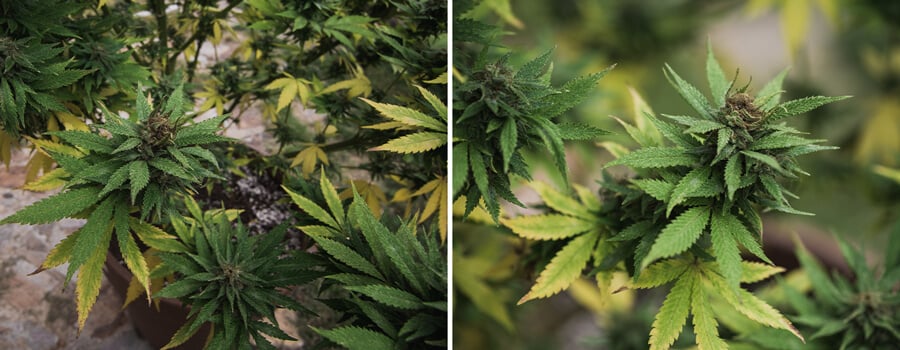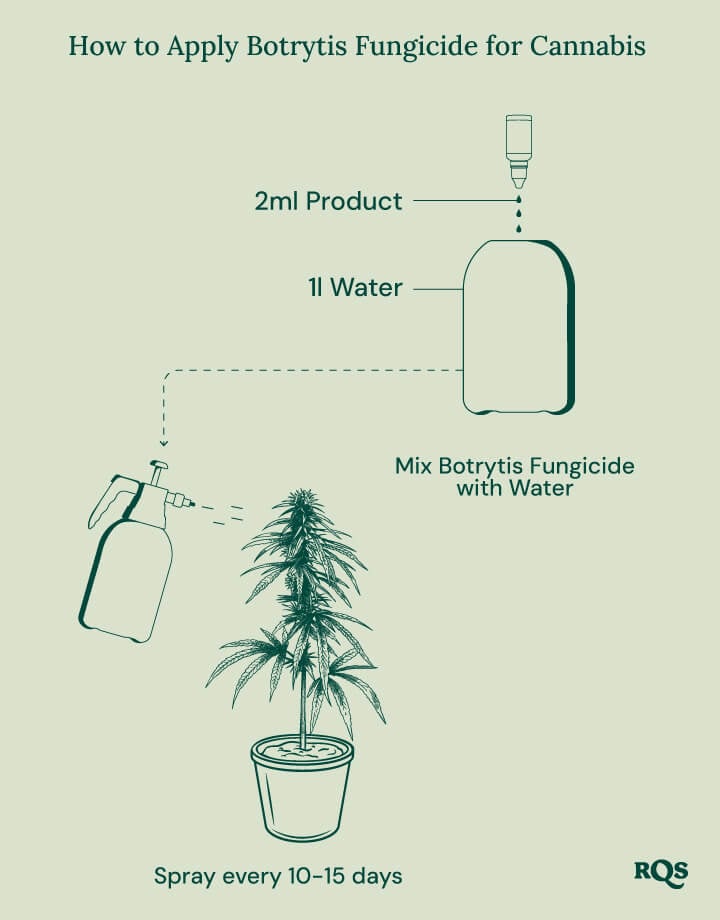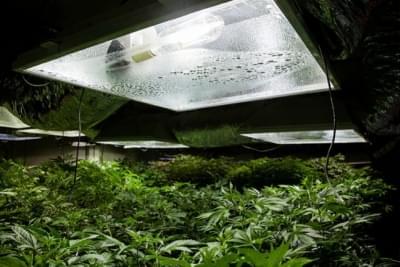.

Botrytis (Bud Rot): How to Prevent This Cannabis Plant Pathogen
There are many different diseases that affect cannabis plants. Among them, Botrytis is one of the most feared. This grey mould secretes compounds that kill off bud tissue, rendering whole harvests useless. Thankfully, there are a range of ways to stop it from getting a foothold, including our revolutionary organic Botrytis Fungicide for Cannabis.
Contents:
Growing your own weed at home is often an easy, enjoyable, and rewarding experience. However, as every seasoned cultivator knows, troubles will pop up from time to time. Among all of the deficiencies, pests, and diseases that threaten a successful harvest, Botrytis stands out as one of the most severe. But what is Botrytis, exactly?
Otherwise known as bud rot, this infection directly targets cannabis flowers, making them completely unusable. Thankfully, the great minds here at Royal Queen Seeds have come up with an effective organic solution: Botrytis Fungicide for Cannabis. Below, you’re going to learn all about Botrytis, how to prevent it, and how to keep your big buds safe with our antifungal plant spray.
Introducing Botrytis or Bud Rot: A Bud-Killing Mold
Numerous fungal organisms are pathogenic to cannabis plants. While some cause only minor cosmetic damage to foliage, the likes of Botrytis cinerea directly target the most precious part of the plant: the buds. The fungus causes a necrotic disease and literally kills off the living tissues of weed flowers. The pathogen breaks down plant cell walls using a range of compounds and proteins, including enzymes, reactive oxygen species, acids, and phytotoxins, allowing it to colonise dead tissue and acquire nutrients.


-
Why is it called Bud Rot? Recognizing the Signs
Bud Rot is another term for the disease, named for its characteristic visual aspect where the buds undergo internal decay. This decay is similar to that seen in other vegetables, where the tissue appears to be consumed from within.
-
The Life Cycle of Botrytis
Botrytis starts off life as microscopic spores that attach themselves to the sugar leaves, trichomes, and stigmas of weed flowers. From here, the spores germinate when exposed to humidity of around 70% and temperatures of 17–24°C. They send out small filaments that penetrate plant tissues and begin releasing decomposing compounds. As colonisation continues, the fungus reaches a stage of maturity and releases spores, starting the cycle all over again.
-
The Symptoms of Botrytis on Cannabis Plants
Cannabis plants exhibit various symptoms over the course of a Botrytis infection. During the early stages, buds typically appear softer than usual. The flowers also tend to feature a slight brown or gray discoloration. Small lesions on buds and stems also become visible during the early stages.
As the infection progresses, more severe symptoms become apparent. Starting from the interior of the buds, patches of dead tissue start to spread to the surface, resulting in large gray and brown patches of necrotic tissue. Mycelial growth becomes increasingly visible and buds become dried out and almost entirely brown. In the final stages, a gray mold will start to appear—a sign of sporulation.


-
What Causes Botrytis on Weed Plants?
Botrytis occurs on cannabis plants for a variety of reasons. The root cause involves the direct contact of Botrytis spores with the sticky surfaces of cannabis flowers. However, blooming weed plants can contract Botrytis spores without exhibiting signs of the pathogen. The real trouble starts when the spores are exposed to favorable environmental conditions. As soon as humidity reaches a level of around 70% during flowering, and temperatures remain high, spores germinate and the infection begins.
Botrytis Prevention & Management
While some problems that growers face, such as pest infestations, have reliable cures, matters are a bit more tricky with Botrytis. Some growers attempt to prune diseased tissue from infected plants, but there’s a high chance that surrounding buds will harbour spores—which can end up in your lungs when you get around to smoking your harvest. It’s a harsh reality, but you should immediately remove and burn plants infected with Botrytis. For this reason, prevention is critical. Stopping Botrytis from getting a foothold in your growing space will save you a lot of heartbreak.
Check out the important tips below to minimise the potential damage of this pesky pathogen.
-
Plant Spacing
Plant spacing can become tricky, especially in a tight growing space. If you have the room, you should space your plants out by at least 100 cm to give them room to grow laterally without touching. This will provide ample aeration while preventing excess humidity and the spread of infection.
-
Pruning
Regularly pruning your plants will thin out their canopies. In turn, this will increase aeration and decrease humidity during bloom. You should also make an effort to prune away lateral branches that cause neighboring canopies to merge and shade each other out.
-
Humidity Control
Humidity ranks as one of the most important factors in preventing full-scale Botrytis infections. Outdoors, position plants in an area that receives good airflow. Ensure you have ventilation at both ends of greenhouses and polytunnels to prevent stagnant air and increased humidity. Indoors, use fans and ventilation to maintain a humidity level of 40–50% during the flowering phase.
-
Defoliation
After pruning away larger branches, focus your attention on problematic foliage during the rest of the growing process. Snip away any older and larger leaves that will prevent optimal aeration. During bloom, remove all leaves that block direct light from hitting all bud sites.


-
Microbiome Optimisation
Much like us, plants also possess a microbiome—a community of friendly microbes that regulates their immunity. Applying biological inputs, such as lactic acid bacteria and aerated compost tea, you’ll blanket your canopy with beneficial organisms. They’ll work to protect your plants from pathogens and decrease the odds of an infection taking hold.
-
Monitor
Frequently monitor your plants during the flowering phase. Spend time carefully assessing individual buds for symptoms of Botrytis infection. Even if you find symptoms on one plant, constant monitoring could help you catch it in time to remove the specimen and protect nearby plants from contamination.
Botrytis Fungicide: A Solution to the Moldy Problem
While the prevention strategies above often help to keep Botrytis infections away, they aren’t bulletproof. To offer growers another solid line of defense to augment these strategies, Royal Queen Seeds created Botrytis Fungicide for Cannabis. This product harnesses the power of minerals, natural acids, friendly microorganisms, and vitamins to keep Botrytis at bay.
-
How This Anti-fungal Spray Works
Our Botrytis Fungicide for Cannabis contains iron, manganese, potassium, polyhydroxycarboxylic acids, beneficial microbes, riboflavin, niacin, and vitamin C. In place of harsh chemical fungicides that can contaminate cannabis flowers, these natural compounds and living organisms synergise in a way that stops Botrytis in its tracks. Together, these ingredients have a direct impact on Botrytis, preventing the fungus from proliferating.
-
How to Apply Botrytis Fungicide for Cannabis
For the best results, you need to regularly keep your plants covered in a protective coating of Botrytis Fungicide for Cannabis.
Create a solution by adding 2–2.5 ml of the product to every litre of water. Apply as a foliar spray every 10–15 days, making sure all parts of your plant are well soaked. Make sure to repeat the application if it rains shortly after applying. Spray this product early in the morning or late in the evening to allow it to take full effect.


-
The Advantages of Botrytis Plant Disease Sprays
As well as the obvious benefits of a decreased risk of Botrytis, this organic garden fungicide offers several other key advantages. Check them out below.
- Safe to Use
- Entirely organic, you don’t have to worry about handling harsh chemicals when using Botrytis Fungicide for Cannabis. Just remember to follow basic safety precautions, such as keeping this product out of reach of children and animals, and away from food and drinks. Shake it well before use, don’t ingest it, and avoid contact with skin and eyes.
- Easy to Use
- Applying this fungicide for flowers is as simple as administering any other foliar spray. Just mix it up into a solution following the instructions above, and spray away liberally during mornings or evenings.
- Perfect Formula
- Our proprietary formula uses natural compounds found to deter Botrytis. However, the presence of nutrients and friendly microbes also increases overall plant health. The minerals in this formula enter the stomata on leaf surfaces, giving plants a boost that they’ll certainly benefit from.
The Fight Against Botrytis: Final Thoughts
By combining Botrytis Fungicide for Cannabis with the other preventative methods detailed above, you’ll give yourself the best fighting chance possible to deter Botrytis and raise healthy and productive cannabis plants. Remember, though, this fungus isn’t the only threat out there. Consider adding SuperVit to your arsenal for overall plant health, Neem Oil for protecting against aphids and other pests, and Propolix for added defense against fungal diseases.







































